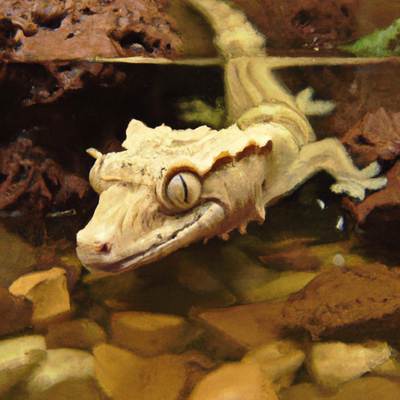Yes, like most geckos, the gargoyle gecko has the ability to swim. But does it like it?
Gargoyle geckos have been shown to swim in puddles and lakes, when necessary. However, when faced with large bodies of water such as rivers, they will usually try to find an alternate route around it
Geckos will float if they fall into fresh or salt water and they instinctively know how to swim towards land. They do not like being submerged, because they are slow an clumsy in water compared to their fast movement on land, and they are easy targets for larger e.g. fish predators from below.
The gargoyle gecko is a lizard with more rounded tails and fingers compared to other geckos e.g. the crested gecko, which gives them a slight disadvantage compared to its sister species.
However, some geckos, such as the Asian house gecko, prefer to run on the surface of the water instead of swimming in it. They may even use the ability to getthrough water bodies blocking their way.
Do geckos like to swim?
Most geckos, including the gargoyle gecko, do not like to stay in water for more than a few minutes at a time.
Gargoyle geckos are native to the tropical climate of the New Caledonia islands, where the temperature is warm and humid and with plenty of rain throughout the year so they do not mind water as such.
Although Gargoyle geckos don’t mind water or high humidity, they do not like swimming.

So if gargoyle geckos fall into the water, they will try and escape from their watery prison by climbing on anything near them.
A gecko with a bit of a different relationship to water is the Asian house gecko.
The Asian house gecko can run on water as fast as it runs on land and it does not get wet from it. The reason why it does not actually swim, but prefers to stay close to the surface of the water is a good indication that geckos do not like to swim.
While watching the Asian geckos swim, some unique things can be observed, such as legs flailing and air bubbles forming around the toes.
This appears to happen because these geckos have super water-repellent skin that will keep the air attached even under water.
If the Asian gecko is trapped under the water, or soap is added to remove the water’s surface tension, its body will sink down and try to swim as fast as possible toward the surface.
However, it does swim much slower when submerged, and it does not seem to enjoy it – in fact, some geckos just give up and lie still floating when submerged in soapy water!
Will gargoyle geckos drown in water?
Like other animals, gargoyle geckos will drown in water if their head is submerged for too long. Being reptiles, they have lungs and not gills, so they cannot extract oxygen from water.
However, they can hold their breath underwater for several minutes before needing air, but they will usually panic way before that time.
Although they can survive without oxygen for short periods they may not swim on their own if submerged completely in water.
If you are ever watching your gecko underwater and notice that the legs are flailing while submerged, it is a sign that your gecko may be panicking and struggling to breathe, and you should help it out right away – or it might drown! And with gargoyle geckos being cute and fairly expensive, you do not want to risk that!
Should you bathe your gargoyle gecko?
Gargoyle geckos are generally very clean animals, so it’s generally not recommended to bathe them. Because geckos, like all lizards, actually produce saliva, they are perfectly capable of cleaning themselves – and the way gargoyle geckos clean their eyes is simply adorable!
If your gecko really needs a bath, it’s best to use a little water and a moist cloth.
Importantly, do not use soap! Soap will damage the normal microbial flora of the geckos skin and will prevent some of the hydrophobic properties of its skin that allows it to swim in the first place.
You should also be careful not to leave your gecko in the water for too long, if you’re concerned about your gecko’s health, it’s best to contact your veterinarian.

Before you bathe your gecko, make sure that the water has a suitable (hand warm) temperature and do not submerge it completely in water.
How long can a gargoyle gecko go without water?
Geckos do not need access to bathing water, but they do need a good source of drinking water.
Gargoyle geckos can go a surprisingly long amount of time without drinking water if it rains and the humidity is high like in their natural habitat of the Solomon Islands.
However, it is recommended to have water in the enclosure at all times and to provide fresh water at least once per week. But you should be able to go two weeks before needing to offer more water.
If your gecko is seen drinking from the bowl less and less over the days, it will be a good idea to change the water completely.
Always check the bowl every day for at least a week after changing the type of water dispenser or water bowl to ensure that your gecko is still drinking from it.
Finally, also make sure that your gecko has the right decor in its terrerium and that the rocks are sterilized before use, the wood is clean and the sand you might use is safe for your reptile!
Without a proper terrerium design, the geco might be stressed and unable to drink well.
Conclusion
While gargoyle geckos spend much of their time living on dry land and very little time walking or swimming around in water, gargoyle geckos do have the ability to swim, but they would not do it for the fun of it!





